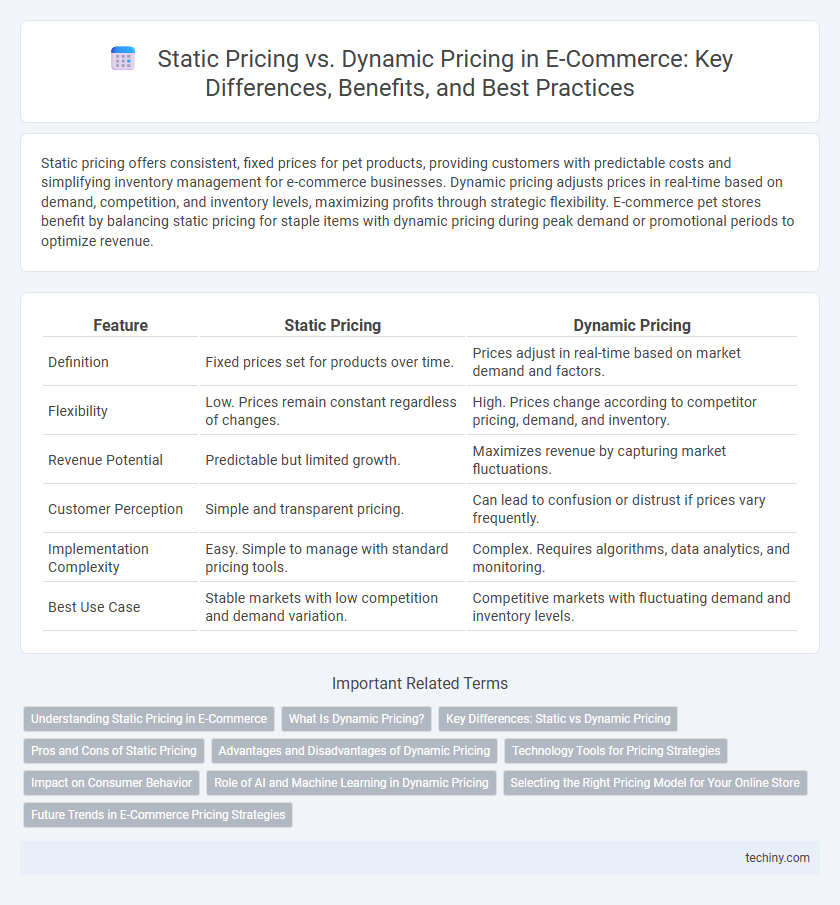Static pricing offers consistent, fixed prices for pet products, providing customers with predictable costs and simplifying inventory management for e-commerce businesses. Dynamic pricing adjusts prices in real-time based on demand, competition, and inventory levels, maximizing profits through strategic flexibility. E-commerce pet stores benefit by balancing static pricing for staple items with dynamic pricing during peak demand or promotional periods to optimize revenue.
Table of Comparison
| Feature | Static Pricing | Dynamic Pricing |
|---|---|---|
| Definition | Fixed prices set for products over time. | Prices adjust in real-time based on market demand and factors. |
| Flexibility | Low. Prices remain constant regardless of changes. | High. Prices change according to competitor pricing, demand, and inventory. |
| Revenue Potential | Predictable but limited growth. | Maximizes revenue by capturing market fluctuations. |
| Customer Perception | Simple and transparent pricing. | Can lead to confusion or distrust if prices vary frequently. |
| Implementation Complexity | Easy. Simple to manage with standard pricing tools. | Complex. Requires algorithms, data analytics, and monitoring. |
| Best Use Case | Stable markets with low competition and demand variation. | Competitive markets with fluctuating demand and inventory levels. |
Understanding Static Pricing in E-Commerce
Static pricing in e-commerce involves setting fixed prices for products that remain constant over time, providing stability and predictability for both retailers and customers. This straightforward approach simplifies inventory management and reduces the complexity of pricing strategies, especially for businesses with seasonal or niche products. Retailers relying on static pricing often benefit from steady profit margins and easier competitive positioning without the need for frequent price adjustments.
What Is Dynamic Pricing?
Dynamic pricing is a strategy where e-commerce businesses adjust product prices in real-time based on market demand, competitor pricing, inventory levels, and customer behavior. Algorithms and machine learning models analyze data to optimize prices, maximizing revenue and sales efficiency. This approach contrasts with static pricing by offering flexibility and responsiveness in highly competitive online markets.
Key Differences: Static vs Dynamic Pricing
Static pricing involves setting fixed prices that remain consistent over time, providing predictability and simplicity for both sellers and customers. Dynamic pricing uses algorithms and real-time data analyses to adjust prices based on market demand, competitor prices, and consumer behavior, maximizing revenue opportunities. The key difference lies in flexibility: static pricing maintains constant rates, while dynamic pricing enables continuous, responsive price changes.
Pros and Cons of Static Pricing
Static pricing offers the advantage of simplicity and predictability, allowing e-commerce businesses to maintain consistent price points that are easy for customers to understand and compare. This pricing strategy reduces administrative costs and avoids the complexity of real-time price adjustments, which can build trust and brand loyalty among consumers. However, static pricing risks losing competitive edge as it lacks responsiveness to market fluctuations, demand shifts, and competitor pricing strategies, potentially resulting in missed revenue opportunities or excess inventory.
Advantages and Disadvantages of Dynamic Pricing
Dynamic pricing enables e-commerce businesses to optimize revenue by adjusting prices based on demand, competitor pricing, and customer behavior, leading to increased sales and profitability. However, frequent price changes may confuse customers and damage brand trust if perceived as unfair or inconsistent. Implementing dynamic pricing requires advanced algorithms and real-time data analysis, which can incur significant costs for smaller retailers.
Technology Tools for Pricing Strategies
Technology tools for pricing strategies in e-commerce include advanced AI-driven platforms and data analytics software that enable real-time price adjustments through dynamic pricing models. Static pricing relies on simpler systems with fixed price points updated infrequently, often lacking responsiveness to market fluctuations. Dynamic pricing tools integrate competitor analysis, demand forecasting, and customer behavior insights to optimize profit margins and enhance competitive positioning.
Impact on Consumer Behavior
Static pricing creates predictability, fostering consumer trust and simplifying purchase decisions, but may lead to reduced urgency and lower conversion rates. Dynamic pricing leverages real-time demand, competition, and inventory data to optimize prices, driving increased purchase frequency and willingness to pay. Consumers often respond to dynamic pricing with heightened sensitivity to price fluctuations, influencing buying patterns and perceived fairness.
Role of AI and Machine Learning in Dynamic Pricing
AI and machine learning play a crucial role in dynamic pricing by analyzing vast amounts of real-time market data, customer behavior, and competitive pricing to optimize product prices continuously. These technologies enable e-commerce platforms to adjust prices automatically based on demand fluctuations, inventory levels, and seasonal trends, maximizing revenue and profitability. Machine learning algorithms improve accuracy over time, ensuring pricing strategies adapt to changing market conditions and customer preferences.
Selecting the Right Pricing Model for Your Online Store
Choosing between static pricing and dynamic pricing for your online store depends on your product type, market competitiveness, and customer behavior. Static pricing offers consistency and simplicity, ideal for stable markets, while dynamic pricing leverages real-time data to optimize prices based on demand, inventory, and competitor actions. Implementing AI-driven pricing tools can enhance decision-making, increasing profitability and customer satisfaction through personalized pricing strategies.
Future Trends in E-Commerce Pricing Strategies
Future trends in e-commerce pricing strategies emphasize the growing adoption of AI-driven dynamic pricing models that analyze real-time customer behavior, market demand, and competitor pricing to optimize revenue. Static pricing remains relevant for brand consistency and simplicity but is increasingly integrated with automated tools to adjust prices during peak seasons or promotional events. Advanced machine learning algorithms and big data analytics will enable more personalized pricing, enhancing customer experience and boosting sales conversion rates.
Static Pricing vs Dynamic Pricing Infographic

 techiny.com
techiny.com